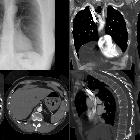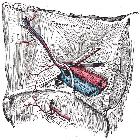abdominal wall hernias
 ähnliche Suchen
ähnliche Suchen siehe auch
siehe auchHiatushernie
Meckel-Divertikel
innere Hernien
Appendix vermiformis
Kolon
Zwerchfellhernie
Lungenhypoplasie
Grynfeltt-Hernie
Mesenterium
Bochdalek'sche Hernie
Zökum
Dünndarm
Spieghel-Hernie
Mesocolon transversum
Trokarhernie
direkte Leistenhernie
Morgagni-Hernie
Intraperitoneale Onlay Mesh (IPOM) Hernien-Operation
Foramen epiploicum
Richter-Hernie
Littre´sche Hernie
incisional hernia
indirekte Leistenhernie
parastomal hernia
epigastrische Hernie
Obturatorhernie
Transabdominale präperitoneale Netzimplantation
Total extraperitoneale Hernioplastik
lumbar herniation
sigmoid
Meckel-Divertikel
innere Hernien
Appendix vermiformis
Kolon
Zwerchfellhernie
Lungenhypoplasie
Grynfeltt-Hernie
Mesenterium
Bochdalek'sche Hernie
Zökum
Dünndarm
Spieghel-Hernie
Mesocolon transversum
Trokarhernie
direkte Leistenhernie
Morgagni-Hernie
Intraperitoneale Onlay Mesh (IPOM) Hernien-Operation
Foramen epiploicum
Richter-Hernie
Littre´sche Hernie
incisional hernia
indirekte Leistenhernie
parastomal hernia
epigastrische Hernie
Obturatorhernie
Transabdominale präperitoneale Netzimplantation
Total extraperitoneale Hernioplastik
lumbar herniation
sigmoid
Abdominal hernias (herniae also used) may be congenital or acquired and come with varying eponyms. They are distinguished primarily based on location and content. 75-80% of all hernias are inguinal.
Content of the hernia is variable, and may include:
- small bowel loops
- mobile colon segments (sigmoid, cecum, appendix)
- mesenteric fat
- other viscera
Complications predominantly relate to bowel incarceration, strangulation, and intestinal obstruction. Large diaphragmatic hernias in infancy may be complicated by pulmonary hypoplasia.
Classification
- ventral: anterior and lateral abdominal hernias
- dorsal
- groin: most common
Subclassification
- anterior abdominal wall herniation
- epigastric hernia
- incisional hernia
- port site hernia
- interparietal hernia
- parastomal hernia
- paraumbilical hernia
- Spigelian hernia
- umbilical hernia
- rectus sheath - rectus sheath hernia
- miscellaneous
- Maydl hernia
- Richter hernia: contains only one wall of a bowel loop
- lumbar herniation
- groin herniation
- inguinal hernia
- direct inguinal hernia
- indirect inguinal hernia: five times commoner than direct
- pantaloon hernia (combined direct and indirect inguinal herniae)
- Busoga hernia
- femoral hernia
- obturator hernia
- inguinal hernia
- diaphragmatic herniation
- internal herniation: an uncommon cause of bowel obstruction
- the left paraduodenal fossa (fossa of Landzert): most common
- the right paraduodenal fossa (fossa of Waldyer)
- the foramen of Winslow (lesser sac)
- a hole in the mesentery (transmesenteric)
- a hole in the transverse mesocolon
- broad ligament hernia
- the superior ileocecal fossa
- the inferior ileocecal fossa
- the retrocecal fossa
- Littre hernia: hernia containing a Meckel diverticulum
- pelvic hernia
Siehe auch:
- Hiatushernie
- Meckel-Divertikel
- innere Hernien
- Appendix vermiformis
- Kolon
- Zwerchfellhernie
- Lungenhypoplasie
- Grynfeltt-Hernie
- Mesenterium
- Bochdalek'sche Hernie
- Zökum
- Dünndarm
- Spieghel-Hernie
- Mesocolon transversum
- Trokarhernie
- direkte Leistenhernie
- Morgagni-Hernie
- Intraperitoneale Onlay Mesh (IPOM) Hernien-Operation
- Foramen epiploicum
- Richter-Hernie
- Littre´sche Hernie
- incisional hernia
- indirekte Leistenhernie
- parastomal hernia
- epigastrische Hernie
- Obturatorhernie
- Transabdominale präperitoneale Netzimplantation
- Total extraperitoneale Hernioplastik
- lumbar herniation
- sigmoid
und weiter:
- axiale Hiatushernie
- Dünndarmileus
- Morgagni-Larrey hernia
- Lendenhernien
- Laterale Bauchwandhernie
- Inguinalhernie
- Inkarzeration
- Petit hernia
- diagnosis of a Symptomatic Left Paraduodenal Hernia in a Newborn
- laparoskopische Leistenhernienoperationen
- supraumbilicales Serom
- small bowel obstruction secondary to paraumbilical hernia
- obstructive ileus caused by herniation of descending colon into the rectus sheath
- Hernien der Leistenregion
- incarcerated Richter hernia
- large bowel obstruction secondary to ventral hernia
- traumatic abdominal wall hernia
 Assoziationen und Differentialdiagnosen zu Bauchwandhernien:
Assoziationen und Differentialdiagnosen zu Bauchwandhernien:




















